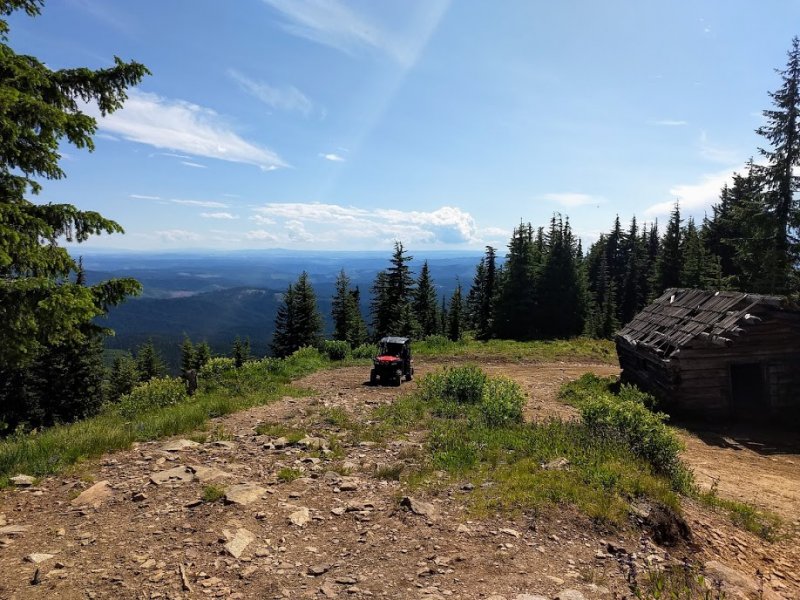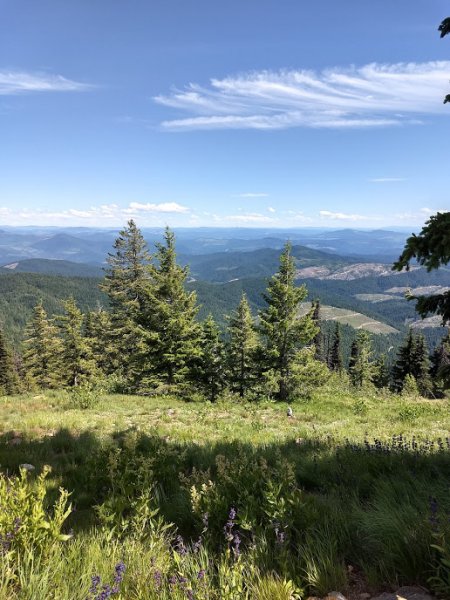Leaderboard
Popular Content
Showing content with the highest reputation on 02/28/2021 in all areas
-
https://www.exploringoverland.com/shop/vdeg4-1a The undisputed bible of backcountry travel. I have Tom Sheppard's original edition and the later 4.1, co-authored with Jonathan Hanson, I prefer the larger format of the older version but plenty of updated info in the newer.4 points
-
Its your point that Southern cousins can reproduce at faster rates than northern cousins. Which by the way is completely wrong in the genus Homo. And looks to be wrong in canids and felines as well. So I have given you examples of Dingos vs Wolves which are closely related and South American cougars and North American cougars which are the same species. They have the same reproductive rates! What does Paleo dogs have to do with modern dogs? The domestication of the Wolf could have happened many times in many places. The family of paleo dogs that helped humans out hunt thals? Could have also gone extinct. Either way it’s a theory that has a lot more weight than your theory that humans just had more babies than thals did because they came from the south. Humans it appears domesticated dogs at one point around the same time as thal populations were collapsing. Dogs could represent the technology niche that thals simply could not cope with. Again I suggest that if want to explore your theory about southern vs northern reproduction rates? Go start your own thread to discuss it.2 points
-
I truly don't know, but i find it strange for sure. I ended up doing that as i was talking to Shane Corson a few weeks back about some recent rock throwing reports out in WA (western of course) and just thought i'd take a look in to what if any, was the public info on other non human primates and found that West African study. What got my interest was the fact that they were showing and pushing the 'cultural behavior' line as i felt it would always be possible to find that within our subject, hence the focus on Washington and that was that. But i didn't stop there....;) In other areas of the PNW and the west coast, there's other 'strange' pockets of both pretty high density 'objects thrown' reports and areas of next to none at all which could possibly suggest that there are learned cultural behaviors within our subject and 'objects thrown' may just be one of them. For example, within the same mountain range as the above numbers but just further south and across state lines, the Oregon Cascades see's way different numbers to what the Washington Cascades see, a mountain range that has a natural divide of a (Columbia) river. Washington Cascades (240 miles in length approx) - 1/14 reports consist of 'objects thrown' out of 419 reports total (7%). Oregon Cascades (360 miles in length approx) - 1/178 reports consist of 'objects thrown' out of 178 reports total (0.05%). That's a big difference. Other notable numbers. Oregon Coastal Range - 1/25 reports consist of 'objects thrown' out of 100 reports total. Eastern Oregon - 1/25 reports consist of 'objects thrown' out of 49 reports total. Pattyville (Klamath Mountains OR and CA) - 1/106 reports consist of 'objects thrown' out of 211 reports total. Sierra Nevada Mountains CA - 1/20 reports consist of 'objects thrown' out of 196 reports total. It's all food for thought if nothing else BUT, at least we have a starting foundation and confirmation of learned cultural behavior in non human primates with that West African study of Chimps, it's something to at least give me the emphasis to spend further time on this kind of stuff.2 points
-
I think so. I mean it’s a small light trail saw. Your not gettin hired as a faller in the woods with it. But it surprisingly has a lot of low end grunt. With two batteries and charger it will easily keep up with a day of 4x4ing. If I was going to go cut cord wood I would want a gas saw along. I like Stihl over Husky. I also have the pole saw. And swap batteries. I actually like the stealth of both of them. No mistake if someone is running a 2 stroke in the woods. Battery just makes chain noise.1 point
-
1 point
-
Great video! Yeah, I knew he worked for the state, but i have never heard the hair/threat of firing story before. John is a very credible person.1 point
-
I never knew John actually operated as a investigator for the state. And then after a hair sample was threatened to be fired. I had heard his original story in the tent.1 point
-
Norseman got it. LR 110. Those Mercedes 230 Gs though..if they had aluminum alloy bodies it would be awfully tempting. https://www.hemmings.com/classifieds/cars-for-sale/mercedes-benz/gelandewagen1 point
-
Most of them are alligators. I see them all the time. The supposed skunk apes here are mostly misidentified displaced primates from our hurricanes.1 point
-
I am quite sure whistling is good as any other method. The important thing is to spend time in the great remote Outdoors with an adequate weapon .1 point
-
Whistling, like rock throwing, may be learned behavior in that is used by some groups and not others. Could be time to call in our resident Squatchermetrics expert one more time for some data? It comes to mind that even tree knocking may be passed down only in certain groups, which may mean that in some areas the practice could be just a big waste of time and energy.1 point
-
It could mean that Eastern and Western '"tribes" don't intermingle enough for some to learn rock-throwing behavior? Similar dynamic to the Chimpanzee study where not all groups, or maybe only one group practiced rock throwing.1 point
-
I looked in to 'objects thrown' a lot recently and found what i believe were some pretty interesting numbers, or lack of them in this case. Also looked in to the general 'throwing' mechanism of both humans and other non human primates and created a couple of documents that i'll attempt to attach if anyone's interested. Chimp Rock Throwing - I've highlighted what i believe to be the most relevant parts of a study in West Africa that points towards 'objects thrown' as being a cultural behavior, meaning not all Chimps do it, with it only being found in specific geographical populations, which is real interesting to me for a number of reasons. Moder(n) Human Throwing Techniques - Again, i've highlighted what i feel is the most relevant info. Chimp Rock Throwing.pdf Moder Human Throwing Technique.pdf1 point
-
Just going to be passive in different areas of Michigan. To see what takes place and see if i can capture it on video. Setting my goal. If it happens it happens if not oh well. But like i said I am taking a more passive approach this year. I just need to by my flir and I will be all set. I have my digital nightvision video camera with attached mic , 5 trail cameras, four GoPro cameras and 1 auto voice recorder. So I am not sure how i am going to be passive with all this stuff. So I guess it will be happy hunting.1 point
-
Every minute I'm out there is one step closer to the possibility anyway. I know they are there and have had what I think is evidence of nearness but is this the year? I hope so. There is no reason why a Sasquatch shouldn't show up in my front yard, Every other large critter and small too has been through--Bear, Moose prints in the drive, Coyote, Fox, Pine Marten, Ermine, Bobcat, Racoon, Whitetail Deer, Porcupine, Cougar reports nearby, Bald Eagles and Osprey shredding fish in the tops of the pines, Barred, Saw Whet and the occasional Great Horned owls. When I built here I chased out the Goshawks, they've better sense than to abide the hairless bipedal abomination. It's only a matter of time before I look out and see the big guy!1 point
-
I have owned a pair of Zamberlan boots for about 3 years now. Best boots I have ever owned. A Navy Seal told me about these boots. His pair had been with him on 10 deployments and were on their 8th resole. The only thing I don't like about them is that I don't have an excuse to buy another pair - these will last me the rest of my life. https://www.zamberlanusa.com1 point
-
Definitely getting closer. For me, there's no need to discover something I'm convinced already exists. My goal is see one unequivocally. A full-on encounter, face-to-face. To better answer your question, I've found an increase in trees coming down last year. As a lifelong hiker and backpacker, I've never once heard a tree come down in my life while enjoying those activities. I've also found tracks in hard-to-find places including a 17" footprint left in water-logged mud. I'm eager to get out in early Spring and press deeper into my areas. Myself and a buddy missed a destination pond last year as the trail got lost going through a cedar swamp. It is my first goal this Spring. I'll bushwhack around the swamp because I think the pond that lies beyond will yield results. So, same areas, deeper penetration.1 point
-
1 point
-
I've lived in Iowa and I absolutely despised it. I went deer hunting a couple of times. Once, at a state park that was literally 100 acres with 20 other hunters showing up to try and get a herd of about 8 deer. It was pathetic and dangerous. The other time was on a private church camp of about 500 acres. I could see houses the whole time I was there. If you can walk in literally any direction and hit a paved road within ten miles, you are not in the woods. Where I go a lot for berry picking and exploring, you can literally head East and not hit a paved road for nearly 100 miles. This is looking East from a lookout site in Idaho. The next paved road is over 100 miles away near Lolo, Montana. There are no towns, no civilization, no power, no nothing for 100 miles. Most city folks and others from populated areas have no concept of just how vast the wilderness is out here.1 point
-
The weather report for Rochester, N.Y. calls for 18% grey. I am a Kodachrome guy, have a lot of slides in dark storage that are older than many forum members / visitors. Very few are aware that Kodachrome slides taken in 1937 look great. I have "Making Kodak Film Expanded Second Edition" by Robert L Shanebrook. Simply amazing.1 point
-
I hear ya. I've had communications with people from the Midwest who call what I'd refer to as a stand of trees as a forest and what I'd call a creek, they call a river. Our family cabin is about a mile outside a small town of pop. 200 and as you continue on the road past our cabin, it's 13 miles before you reach another road. I know by comparison that what BCWitness photographed is far more vast.1 point
-
I sure do, @JustCurious, every time I go out in the hills. There are reports from all around my area, Mission, Aggasiz, Harrison, Chilliwack Valley, and just south of the border, in Northern Wa. My own sighting and trackway find, 40+ years ago, were in a valley that I still visit regularly, just 40 minutes NE of my home.1 point
-
I had an adventure on Sunday afternoon, which started with a post, about 1:00 PM, on a local 4x4 facebook group. A lady posted that she had just got a message from her sister, I assume via inreach, as there's no cell service out that way, that she was stranded about 4km in on Foley Lake FSR. Since I live about an hour from that spot, I offered to drive out in the H3 to see if I could help. The area has several sighting reports, so it would gave me an excuse to revisit a stretch of logging road that I hadn't been to in at least a decade. Half an hour later I entered the Chilliwack River valley, and soon was out of cell service, as the mountains close in and settlement ends. Another 20 minutes, and I was at the start of the Foley Lake FSR, where it branches off the Chipmunk Creek FSR. I immediately hit the snow line, and giant potholes in the road, some of them 30' long and flooded 18" deep, one after the other, making progress quite slow and tedious. I reached the 4km mark without seeing any damsel in distress, so I continued up the now steeply climbing trail, with the snow getting deeper as I went, until there were no more tire marks in the snow, and a steep landslide across the road, so I knew there was no chance of a vehicle further in. Turning around was tricky on the narrow trail, with 10" of snow, and a 50' drop off the side to the lake, but low range and locking the rear diff got it done, though it was more like a 6 point turn, than a 3 pointer! On the way back to Chipmunk, I watched the snow carefully for tracks, and saw lots of deer prints, but nothing larger. Once I was back to the river, I chose to take the long way home, via the Chilliwack Bench road, rather than the paved valley road on the other side of the river, as it goes through about 20 km of second growth forest before getting back to town. It was a bit muddy in places, since the last week had seen rain every day, but it was clear and bright for the trip, so it was vey enjoyable, and quite scenic. No Sasquatches were sighted, and no stranded ladies rescued, but I felt better for having tried. On my return to home, I checked with the original poster, and was told that someone else had come across her before I got there, and got her going, so she was safely back at home. Here's my phone pics of some of the area: The last one shows the Chilliwack River in the distant valley bottom, and the one above shows that my mud flaps don't help much!!1 point
-
Norseman, I mentioned my theory in passing only. You and some others couldn't understand something very simple and began asking me about it. And you still come back with "Patagonian Puma vs. Montana Cougar" and questions about wild dogs. Do you understand what a species is??????? How can you miss the point over and over and over? But let's drop this lesson and move on to yours. Do you have any, just one scrap, one hint of proof that these three Paleolithic dogs either contributed to the genome of the modern dog or contributed to the extinction of the Neanderthals in any way at all?-2 points
This leaderboard is set to New York/GMT-05:00















